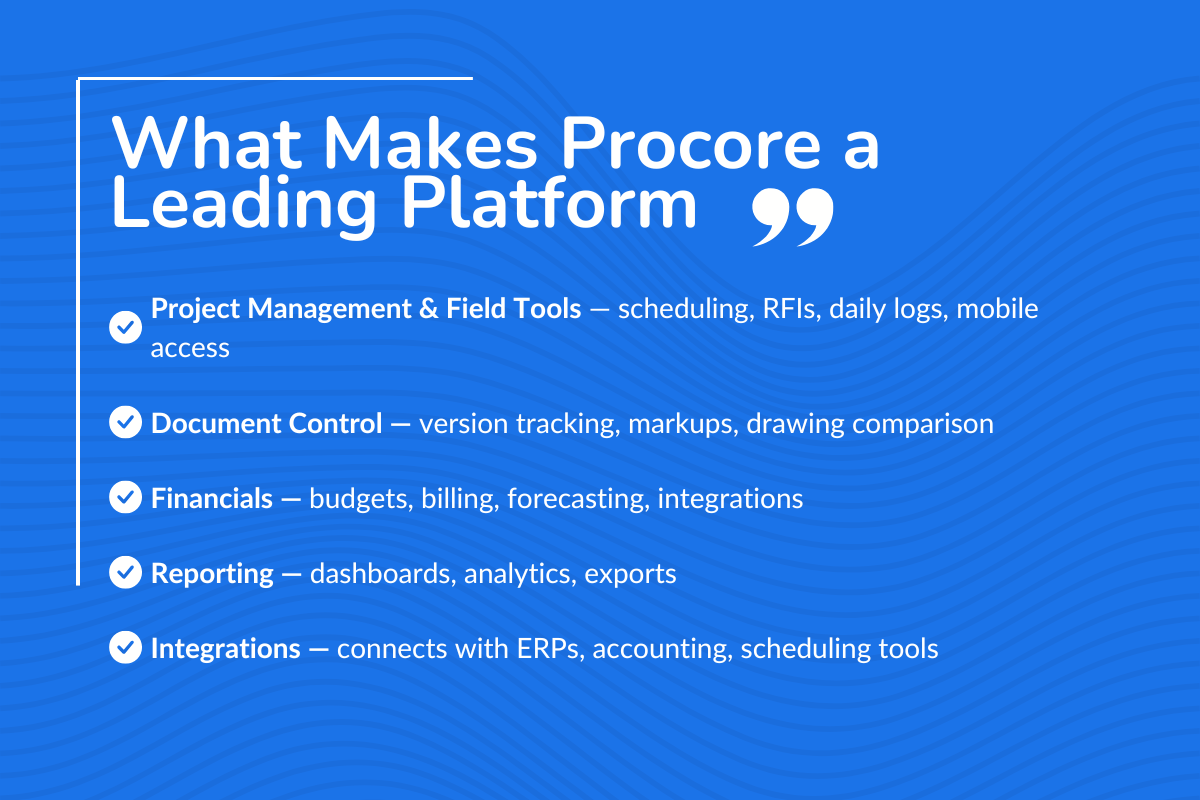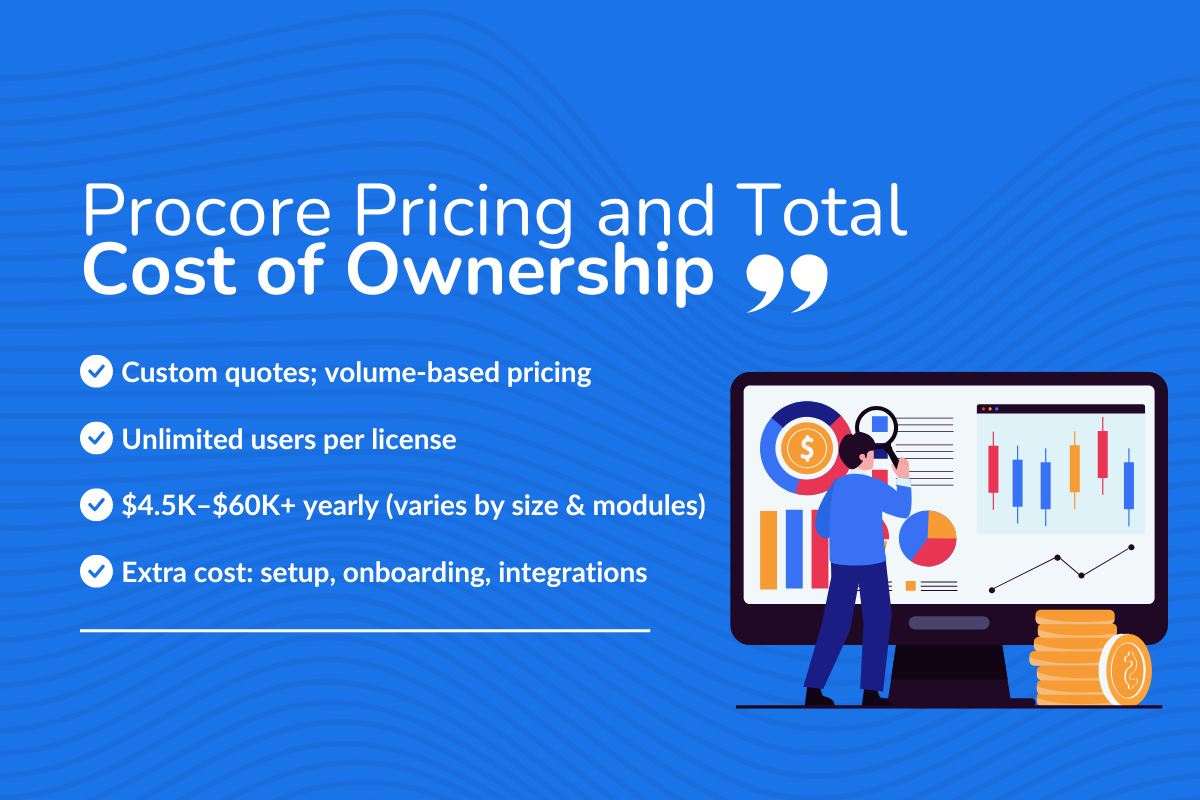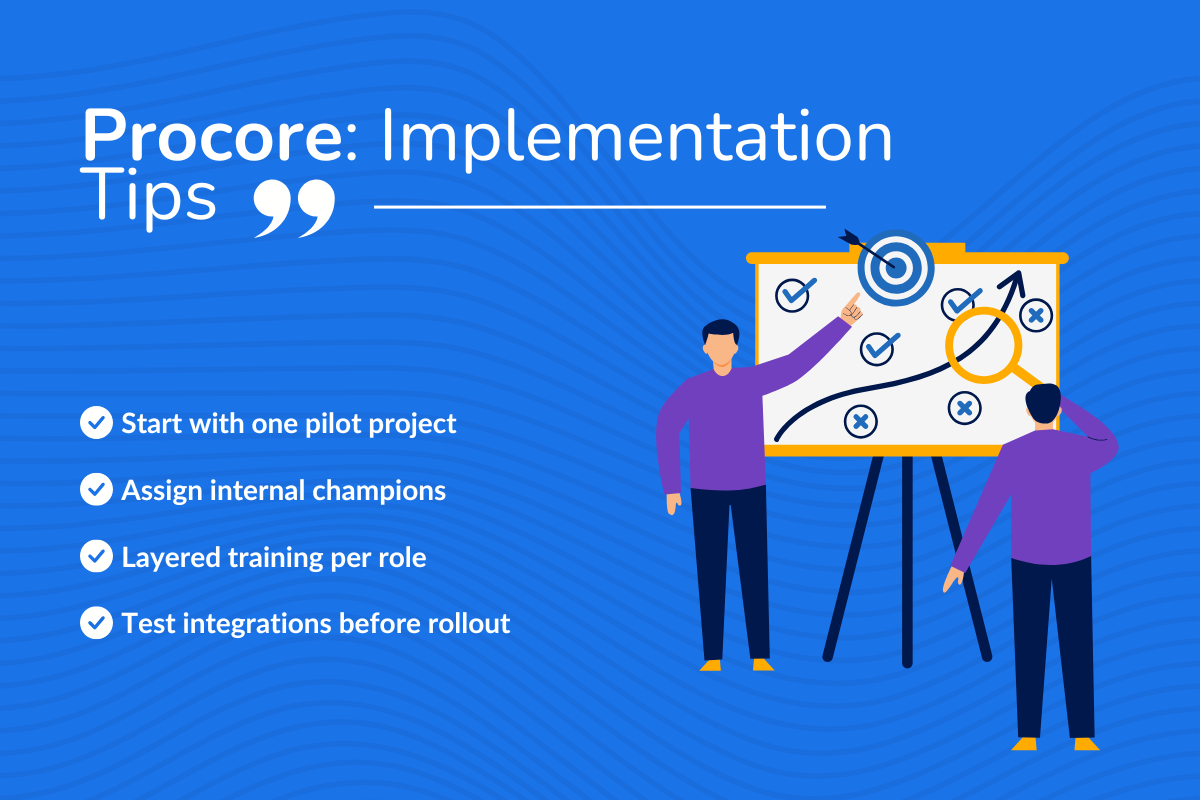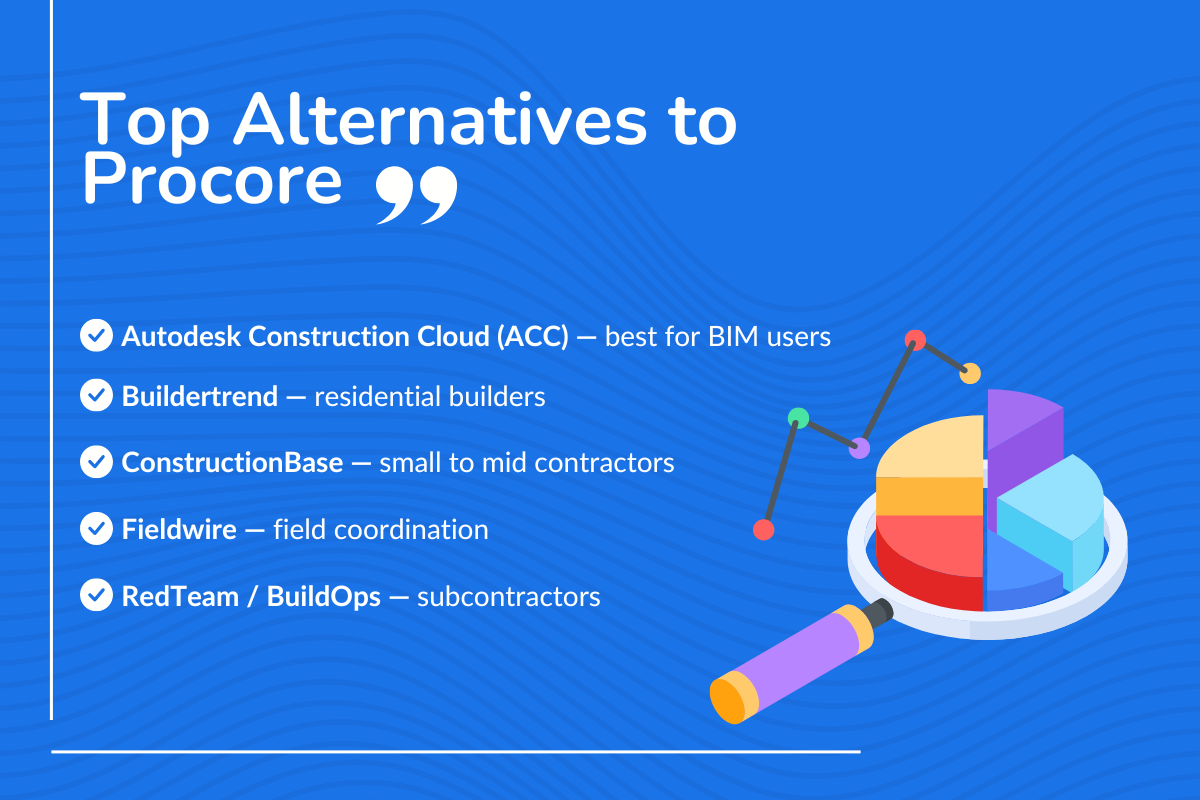If you work in the construction industry, you’ve probably heard of Procore Technologies. It’s the go-to name people drop when talking about project management software: it's powerful, well-known, and, depending on who you ask, either a lifesaver or a headache.
That’s the thing about Procore: for some teams, it’s the backbone of their operation. For others, it’s an expensive tool that takes months to set up and never quite fits their workflow.
In this article, we’ll break down Procore’s features, pricing, and limitations, so you can see where it truly shines and where simpler alternatives do the job just as well.
Is Procore Worth It? Complete Breakdown of Features, Cost & Pitfalls
Before evaluating if Procore is the right choice for your team, it’s important to understand what the platform offers.
Designed to streamline construction workflows, it brings together project management, financials, and field operations in a unified platform.
In the following sections, we’ll take a closer look at Procore’s core features, pricing model, and the common challenges users report.
Key Takeaways
- Procore is a comprehensive construction management platform that connects teams, documents, and workflows into a single system.
- It offers robust tools for project management, budgeting, collaboration, and reporting, making it ideal for mid- to large-sized construction firms.
- Many general contractors and specialty contractors find the platform complex to implement and costly to maintain.
- Understanding its features, pricing, and limitations helps contractors decide whether Procore fits their project scale and long-term goals.
- Lighter, more accessible alternatives may offer similar functionality for smaller or fast-moving teams.
What Makes Procore a Leading Construction Management Platform

At its core, Procore is a single global platform that connects every phase of a construction project from planning and design to execution and delivery. It reduces communication gaps by centralizing information.
The platform’s strength lies in its ability to manage complex workflows, maintain document accuracy, and provide visibility across job sites through integrated dashboards and field tools.
1. Project Management and Field Tools
Procore’s project management module brings every aspect of on-site and office coordination under one platform. It helps teams plan, execute, and monitor tasks with better visibility across all active projects.
Key tools and functions include:
- Scheduling and Task Tracking: Build and manage timelines, assign tasks, and monitor progress to avoid project delays.
- RFIs, Submittals, and Change Orders: Simplify documentation and approval workflows for faster decision-making.
- Daily Logs and Site Photos: Capture real-time updates from the field to maintain transparency and accountability.
- Mobile and Field Access: The Procore mobile app lets teams upload images, report issues, and view updated drawings directly from the jobsite, while offline mode ensures teams working in low-connectivity areas can keep recording data and sync everything automatically once they’re back online.
Why it matters: For general contractors and specialty contractors, this centralization reduces miscommunication, increases efficiency, and ensures that office and field teams stay aligned at every project stage.
2. Document and Drawing Management
Effective document control is one of Procore’s strongest capabilities. It keeps every version, markup, and update in one place, so teams always work from the latest drawings without second-guessing what’s current.
Core features include:
- Version Control: Automatically tracks drawing revisions so everyone works from the latest set of plans.
- Markup and Commenting Tools: Allow teams to add notes, highlight changes, and tag users directly within drawings.
- Drawing Comparison and Collaboration: Overlay old and new versions to identify design or scope changes quickly.
Why it matters:
Combining document management, field access, and version tracking in one place enables construction professionals to collaborate efficiently without confusion over versions.
3. Financials and Budget Control
Managing budgets is one of the main reasons contractors choose Procore, as the platform helps teams track project costs, manage invoices, and stay on top of change orders without jumping between spreadsheets or emails.
Core tools include:
- Budget Tracking and Forecasting: Build and update budgets in real time to keep projects aligned with actual costs.
- Progress Billing and Change Orders: Manage approvals, invoices, and payment schedules from one dashboard.
- Contract Management: Store all contract details in one place to avoid version confusion or missed terms.
- Integrations with Accounting Tools: Sync data with Sage 300, QuickBooks, and other systems to keep budgets, invoices, and actual costs aligned.
Why it matters:
Accurate cost tracking helps project managers catch overruns early and keeps cash flow predictable across multiple jobs. This becomes a major advantage for growing teams balancing several active projects.
4. Reporting, Dashboards, and Insights
Procore gives teams a clear view of how projects are performing, from budgets and schedules to safety checks and field productivity.
The reporting tools help everyone see what’s working and what needs attention before small issues turn into delays.
Core tools include:
- Custom Dashboards: Build visual reports that track progress, costs, and upcoming deadlines across multiple projects.
- Data-Driven Insights: Turn daily site activity into reports that help forecast performance, costs, and resource use.
- Work-in-Progress Reports: Keep financial data updated with real-time numbers for more accurate forecasting.
- Analytics and Exports: Export reports or connect data to external systems for deeper analysis or client updates.
Why it matters:
For busy project managers, these dashboards replace endless spreadsheets and status calls. Clear, real-time data helps teams make decisions faster and keeps leadership aligned without extra reporting work.
5. Integrations and Ecosystem
Procore connects with hundreds of third-party apps, making it easier for teams to keep their tools and data in sync. From accounting systems to scheduling software, it acts as the hub that ties every part of the business together.
Core integrations include:
- Accounting and ERP Tools: Sync budgets, invoices, and cost codes with Sage 300, QuickBooks, and similar systems.
- Scheduling and Estimating Apps: Link Procore timelines with external scheduling tools for consistent project tracking.
- Workforce and Safety Tools: Connect HR, compliance, and labor management apps to keep site operations running smoothly.
- Construction Tech Stack Integration: Procore fits into a company’s broader construction tech stack, bridging field apps, analytics dashboards, and reporting systems under one workflow.
Why it matters:
These integrations save time, reduce double entry, and keep teams working from accurate data. For growing firms, the ability to plug in existing tools makes Procore a leading technology partner for construction firms seeking integrated project visibility.
Procore Pricing and Total Cost of Ownership

Procore doesn’t publish fixed pricing on its website, so it requires custom quotes for every client. Pricing varies by annual construction volume, selected modules, and project scope, rather than by a flat per-user cost.
1. Pricing Overview
Available Plan Tiers (as listed by Procore):
- Essentials: Core tools for project execution and document management.
- Enhanced: Adds cost management and reporting capabilities.
- Premier: Full suite with advanced analytics, integrations, and financial tracking.
Each plan follows a “Get a Quote” model with no publicly listed prices. (source)
General Industry Benchmarks (Based on Third-Party Reports):
- Monthly Estimates: Typically $375 per month per user for small teams, depending on the scale of the project and the features selected.
- Annual Estimates: Around $4,500–$10,000 for small contractors; $20,000–$60,000+ for mid-size firms; $80,000+ for enterprise deployments.
- Percentage-Based Pricing: Often 0.1–0.3% of annual construction volume (ACV), depending on module mix and implementation complexity.
Modular Customization:
Procore allows companies to select only the features they need, such as Project Management, Financials, or Field Productivity, making pricing flexible but also inconsistent across users.
(Sources: Planyard, Tekpon, Ascent Consulting)
2. Hidden and Secondary Costs
Beyond the base subscription, several indirect costs shape Procore’s real price tag:
- Setup and Configuration: Implementation often involves paid onboarding or internal IT hours.
- Customization: Adjusting templates, permissions, and workflows for specific projects adds both time and consulting cost.
- Third-Party Tools: Integrating estimating, accounting, or scheduling apps can raise overall spend.
- Renewal and Support: As project volume grows, renewals and premium support tiers can increase annual costs.
These additional expenses make Procore a long-term operational investment, not just a software license.
3. Sample Cost Scenarios
While Procore doesn’t share public pricing, consistent benchmarks across industry sources give a realistic sense of cost.
While no two companies pay the same, most contractors fall into predictable spending brackets:
- A small general contractor running a few concurrent projects might spend enough to cover only core project management and document control.
- A mid-size construction firm typically pays more to get cost management, analytics, and integrations.
- Enterprise-level organizations with multiple divisions invest heavily in full-suite setups, data migration, and premium support tiers.
These examples illustrate relative cost behavior, not fixed numbers. Actual pricing depends on project scale and selected modules.
4. Pricing Pros and Cons
| Pros | Cons |
|---|---|
| Unlimited users per license make scaling easier for large teams. | High upfront and recurring costs can be restrictive for small contractors. |
| Modular design lets companies tailor plans to their specific workflows. | Teams often pay for modules they rarely use. |
| Enterprise-grade features justify the cost for complex, multi-project operations. | Set up and admin configuration require ongoing internal time or IT support. |
| — | A complex billing structure makes long-term budgeting and forecasting difficult. |
Procore Limitations and Real-World Challenges

Even with its strong reputation, Procore comes with challenges that many teams discover after implementation. Most revolve around setup complexity, onboarding, and the cost-to-value ratio for smaller contractors.
1. Steep Learning Curve
Procore’s setup can feel overwhelming, especially for first-time users.
- Training-Heavy Rollouts: Teams often need dedicated onboarding sessions or paid support.
- Complex Permissions: Setting roles and access levels requires time and admin oversight.
- Adoption Lag: Teams new to digital project tools may take months to use the system fully.
2. Onboarding and Adoption Issues
Not every stakeholder adapts easily to Procore.
- Subcontractor Resistance: Many subs prefer simpler tools or email-based communication.
- External Access Barriers: Inviting outside users can lead to confusion with permissions and visibility.
- Slower Ramp-Up: Large project teams often face a longer adjustment period.
3. Admin Overhead and Complexity
Managing Procore internally can become a full-time responsibility.
- Configuration Workload: Customizing workflows and templates demands technical support.
- Notification Fatigue: Frequent alerts can clutter inboxes and make important updates easy to miss.
- Maintenance Tasks: Regular cleanup of documents and forms adds to the admin load.
4. Cost vs. Usability Trade-Off
The platform’s strength, its depth, can also be its biggest drawback.
- Underused Modules: Many teams pay for tools they rarely touch.
- High Long-Term Costs: Ongoing subscriptions, training, and support add up quickly.
- Better for Enterprise Scale: Smaller firms may struggle to justify the price compared to usage.
5. Real-World Feedback
User feedback is consistent across most review sites.
- G2 and Capterra Reviews: 4.5/5 across 2,000+ reviews, users praise Procore’s power and structure but mention its steep learning curve.
- Community Forums: Common complaints include slow onboarding and high overall cost.
- General Consensus: Excellent for control and reporting, but heavy for small to mid-sized firms.
Also read: How to Evaluate and Select the Best Construction Management Software for Your Firm.
When Procore Works Best

Procore is best suited for companies running multiple large projects with complex coordination needs. It’s built for organizations that can dedicate time and resources to full implementation and ongoing training.
Procore works best for:
- Enterprise Contractors: Firms managing several large-scale or public infrastructure projects at once.
- Commercial Builders and Developers: Teams that rely on advanced reporting, financial tracking, and audit control.
- Firms with In-House IT or Operations Teams: Companies equipped to handle integrations, updates, and admin configuration.
- Workforce Management at Scale: Businesses that need to plan labor, monitor field productivity, and connect workforce data with project schedules.
Implementation and Adoption Tips

Switching to a platform as robust as Procore takes planning and patience. The most successful rollouts happen when companies treat implementation like a project of its own with clear goals, timelines, and internal accountability.
1. Audit Your Current Systems:
Before migrating, map out existing tools and workflows. Identify what’s working, what’s redundant, and what Procore should replace. This helps avoid paying for duplicate functionality.
2. Start With a Pilot Project:
Run Procore on a single, controlled project before rolling it out company-wide. A pilot helps surface integration issues and lets teams get comfortable with the new workflow.
3. Assign Internal Champions:
Nominate one or two people from each department as product leads. These “champions” can handle admin setup, permissions, and day-to-day troubleshooting, reducing dependence on external support.
4. Train in Layers:
Instead of lengthy one-time training sessions, use short, role-specific workshops. Teach project managers, field staff, and finance teams separately.
5. Test Integrations Before Going Live:
If you rely on accounting or scheduling software, confirm that those systems connect properly to Procore before scaling. Data mismatches during live projects can cause major delays.
6. Backup and Documentation:
Keep copies of critical project data during the transition. Document naming conventions, permissions rules, and standard workflows to help new hires onboard faster.
7. Monitor and Adjust:
Review adoption metrics after 30, 60, and 90 days. Track logins, module usage, and feedback, then simplify or retrain where needed to maintain engagement.
Top Alternatives to Procore Technologies

If Procore’s complexity or cost feels out of reach, here are some strong alternatives you can consider:
1. Autodesk Construction Cloud (ACC)
Autodesk Construction Cloud (ACC) offers deep integration with BIM and CAD software, making it ideal for design-driven or preconstruction-heavy workflows.
Its unified environment connects design, cost, and field execution, which becomes a natural fit for companies working across digital modeling platforms.
Best for: Firms already using Autodesk design tools.
Pricing:
ACC offers modular pricing based on selected products, user count, and company size. Pricing is customized, with no fixed public rates, so requesting a quote is necessary.
2. Buildertrend
Buildertrend is popular among small to mid-sized construction firms for its simple interface, affordable plans, and fast setup.
It combines scheduling, client communication, and invoicing tools in one platform, becoming ideal for homebuilders who don’t need enterprise-level complexity.
Best for: Residential builders and remodelers.
Pricing:
Current pricing is available only by direct quote, as rates can vary based on company size, plan choice, and specific requirements.
Industry sources and software review sites report that typical monthly pricing falls between $499 and $1,099 per month as of 2025, but your actual costs may differ. For transparent and up-to-date pricing, visit Buildertrend’s official pricing page to request a tailored quote.
3. ConstructionBase
ConstructionBase is an all-in-one software that delivers core construction management features like scheduling, document control, and financial tracking in an intuitive, lightweight platform.
With real-time dashboards, mobile-friendly access, and seamless integration with CRM and proposal tools, ConstructionBase helps your team stay aligned from bidding to project delivery.
It’s designed for teams that find enterprise systems like Procore too complex or expensive but still want an all-in-one solution that scales. What truly sets it apart is its scalability and simplicity.
Best for: Small and mid-sized contractors who want simplicity without sacrificing performance.
Pricing:
ConstructionBase does not provide fixed or publicly disclosed pricing on its website.
Pricing is customized depending on the size of your company, the number of projects, and specific feature needs. To get accurate pricing, request a quote or demo via their official contact page.
4. RedTeam or BuildOps
Both RedTeam and BuildOps emphasize affordability and deployment speed. They cover the essentials, estimating, scheduling, and field reporting, without the heavy configuration that Procore often requires. These tools work well for growing teams that want control without the overhead.
Best for: Subcontractors and small general contractors.
Pricing:
RedTeam: RedTeam provides flexible pricing based on active project value (APV), with base subscriptions typically starting around $729 per month for up to $5 million in APV. Pricing scales depending on project volume and selected features. Direct contact with RedTeam is necessary for a tailored quote.
BuildOps Pricing: BuildOps follows a custom pricing model with no fixed public prices. Pricing depends on your project size and product configuration.
5. Fieldwire
Fieldwire takes a field-first approach to task management and punch lists. It’s lightweight, mobile-friendly, and easy to train crews on, making it perfect for smaller contractors or firms focused on site productivity rather than complex reporting.
Best for: On-site coordination and field teams.
Pricing:
Fieldwire offers transparent, tiered pricing with plans designed to fit teams of all sizes:
- Basic: Free, limited to 5 users and 3 projects,
- Pro: $39 per user/month,
- Business: $59 per user/month,
- Business Plus: $89 per user/month
Check out: Best Construction Management Software Solutions in 2025
Choosing Between Procore and Alternatives
| Software | Best For | Complexity | Starting Price (approx) | Notes on Pricing | Key Strengths |
|---|---|---|---|---|---|
| ACC | Firms already using BIM/CAD tools | Advanced | Custom Quoting | Modular, depends on chosen products, users & company size | Seamless design-to-build integration |
| Buildertrend | Residential builders and remodelers | Moderate | ~$499/month | Tiered plans, detailed prices on request | Flexible pricing and quick onboarding |
| Fieldwire | On-site coordination and field teams | Simple | Free to $89/user/month | Tiered plans from free Basic to Business Plus with advanced features | Lightweight, mobile-first task management |
| RedTeam | Subcontractors and small GCs | Simple | ~$729/month | Based on active project value, it scales with project volume | Lower cost, fast setup, focused workflows |
| ConstructionBase | Small to mid-sized contractors | Moderate | Custom Quoting | Custom quotes based on company size & project scope | Easy-to-use, all-in-one alternative for teams that find Procore too complex |
Bottom line: When Procore feels like overkill, platforms like
ConstructionBase
deliver the essentials without the heavy setup or enterprise price tag.
Conclusion
Procore stands out for its depth and reliability, but it isn’t a one-size-fits-all solution. For large construction companies managing multiple projects, it offers unmatched control, visibility, and accountability.
But for smaller or mid-sized teams, the same features can feel heavy, costly, and difficult to adopt fully.
If your team needs a system that’s easier to roll out, faster to learn, and built for practical, day-to-day use, tools like ConstructionBase offer a realistic alternative.
You’ll still get the essentials without the steep learning curve or enterprise pricing.
In short, Procore is a strong fit for enterprises with complex needs. For growing contractors, a simpler, more flexible platform like ConstructionBase helps you stay organized, move faster, and build toward a better future, minus the overhead.
Power your projects with ConstructionBase
Turn complex construction workflows into profit-driven results. Head over to book your demo today with ConstructionBase to see how it can work for your team and simplify project management without the complexity.
FAQs
1. What is Procore used for?
Procore is a construction management platform that helps contractors, project owners, and builders manage documents, budgets, schedules, and communication across all stages of a construction project.
2. How is Procore priced, and where is it based?
Procore follows a custom pricing model based on company size, active projects, and selected modules. The company is headquartered in Carpinteria, CA, and provides quotes individually rather than publishing standard pricing tiers.
3. Is Procore good for small contractors?
Procore offers extensive features, but it’s often considered too complex and costly for small teams. Lighter tools such as ConstructionBase or Buildertrend tend to be better fits for contractors managing fewer projects.
4. What are Procore’s biggest weaknesses?
Users often cite a steep learning curve, long onboarding time, and higher overall cost as drawbacks. Managing permissions and configurations can also be challenging without a dedicated admin team.
5. Which software is better for small GCs: Procore or Buildertrend?
For general contractors managing multiple, large-scale projects, Procore delivers more depth and control. For smaller GCs, Buildertrend or ConstructionBase provides faster setup, simpler workflows, and better pricing flexibility.
Have questions or need personalized advice?
Talk to an Expert Today and let our construction specialists guide you to success.







